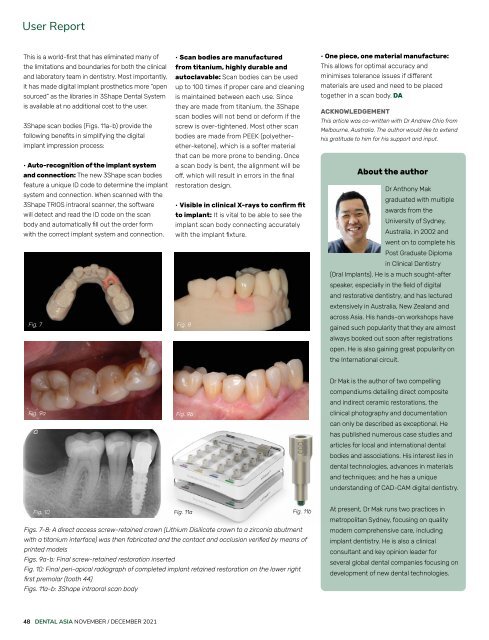Dental Asia November/December 2021
For more than two decades, Dental Asia is the premium journal in linking dental innovators and manufacturers to its rightful audience. We devote ourselves in showcasing the latest dental technology and share evidence-based clinical philosophies to serve as an educational platform to dental professionals. Our combined portfolio of print and digital media also allows us to reach a wider market and secure our position as the leading dental media in the Asia Pacific region while facilitating global interactions among our readers.
For more than two decades, Dental Asia is the premium journal in linking dental innovators
and manufacturers to its rightful audience. We devote ourselves in showcasing the latest dental technology and share evidence-based clinical philosophies to serve as an educational platform to dental professionals. Our combined portfolio of print and digital media also allows us to reach a wider market and secure our position as the leading dental media in the Asia Pacific region while facilitating global interactions among our readers.
You also want an ePaper? Increase the reach of your titles
YUMPU automatically turns print PDFs into web optimized ePapers that Google loves.
User Report<br />
This is a world-first that has eliminated many of<br />
the limitations and boundaries for both the clinical<br />
and laboratory team in dentistry. Most importantly,<br />
it has made digital implant prosthetics more “open<br />
sourced” as the libraries in 3Shape <strong>Dental</strong> System<br />
is available at no additional cost to the user.<br />
3Shape scan bodies (Figs. 11a-b) provide the<br />
following benefits in simplifying the digital<br />
implant impression process:<br />
• Auto-recognition of the implant system<br />
and connection: The new 3Shape scan bodies<br />
feature a unique ID code to determine the implant<br />
system and connection. When scanned with the<br />
3Shape TRIOS intraoral scanner, the software<br />
will detect and read the ID code on the scan<br />
body and automatically fill out the order form<br />
with the correct implant system and connection.<br />
Fig. 7<br />
• Scan bodies are manufactured<br />
from titanium, highly durable and<br />
autoclavable: Scan bodies can be used<br />
up to 100 times if proper care and cleaning<br />
is maintained between each use. Since<br />
they are made from titanium, the 3Shape<br />
scan bodies will not bend or deform if the<br />
screw is over-tightened. Most other scan<br />
bodies are made from PEEK (polyetherether-ketone),<br />
which is a softer material<br />
that can be more prone to bending. Once<br />
a scan body is bent, the alignment will be<br />
off, which will result in errors in the final<br />
restoration design.<br />
• Visible in clinical X-rays to confirm fit<br />
to implant: It is vital to be able to see the<br />
implant scan body connecting accurately<br />
with the implant fixture.<br />
Fig. 8<br />
• One piece, one material manufacture:<br />
This allows for optimal accuracy and<br />
minimises tolerance issues if different<br />
materials are used and need to be placed<br />
together in a scan body. DA<br />
ACKNOWLEDGEMENT<br />
This article was co-written with Dr Andrew Chio from<br />
Melbourne, Australia. The author would like to extend<br />
his gratitude to him for his support and input.<br />
About the author<br />
Dr Anthony Mak<br />
graduated with multiple<br />
awards from the<br />
University of Sydney,<br />
Australia, in 2002 and<br />
went on to complete his<br />
Post Graduate Diploma<br />
in Clinical Dentistry<br />
(Oral Implants). He is a much sought-after<br />
speaker, especially in the field of digital<br />
and restorative dentistry, and has lectured<br />
extensively in Australia, New Zealand and<br />
across <strong>Asia</strong>. His hands-on workshops have<br />
gained such popularity that they are almost<br />
always booked out soon after registrations<br />
open. He is also gaining great popularity on<br />
the International circuit.<br />
Fig. 9a<br />
Fig. 9b<br />
Dr Mak is the author of two compelling<br />
compendiums detailing direct composite<br />
and indirect ceramic restorations, the<br />
clinical photography and documentation<br />
can only be described as exceptional. He<br />
has published numerous case studies and<br />
articles for local and international dental<br />
bodies and associations. His interest lies in<br />
dental technologies, advances in materials<br />
and techniques; and he has a unique<br />
understanding of CAD-CAM digital dentistry.<br />
Fig. 10 Fig. 11a Fig. 11b<br />
Figs. 7-8: A direct access screw-retained crown (Lithium Disilicate crown to a zirconia abutment<br />
with a titanium interface) was then fabricated and the contact and occlusion verified by means of<br />
printed models<br />
Figs. 9a-b: Final screw-retained restoration inserted<br />
Fig. 10: Final peri-apical radiograph of completed implant retained restoration on the lower right<br />
first premolar (tooth 44)<br />
Figs. 11a-b: 3Shape intraoral scan body<br />
At present, Dr Mak runs two practices in<br />
metropolitan Sydney, focusing on quality<br />
modern comprehensive care, including<br />
implant dentistry. He is also a clinical<br />
consultant and key opinion leader for<br />
several global dental companies focusing on<br />
development of new dental technologies.<br />
48<br />
DENTAL ASIA NOVEMBER / DECEMBER <strong>2021</strong>


















